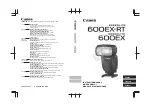
Lens Control (continued...)
The following factors may affect autofocus:
• Target not central within field of view.
• Multiple targets are near and far simultaneously in the field of view.
• Target object extremely bright and causes lens flare.
• Target moving too fast.
• Target is behind glass which has water droplets or dust contamination
• Target is too dark or vague.
Auto White Balance
The PTZ-16 automatically adjusts white balance (WB) according to the amount of background light to provide a true colour
representation of the field of view.
Back Lighting Compensation (BLC)
If the field of view has a bright background the target subject may appear dark or as a silhouette as the iris struggles with the
variance of light. Backlight compensation enhances the target objects in the center of the picture. The camera processor
uses the center of the picture as a focal point from which to adjust the Iris.
Auto Cruise
The camera has the facility to store 39 preset positions into a ‘cruise list’ which when actioned will cycle through each
position in the list.
Auto, Random and Frame Scan
• Auto scan - The camera scans 90 degrees in either direction automatically through a 180 degree sweep.
• Random scan - when activated the camera will scan to random positions throughout it’s 360 degree sweep.
• Frame scan - scans the camera 45 degree left and 45 degree right through a 90 degree sweep.
Image Flip
In the majority of installations the PTZ-16 will be installed in a hanging position (upside down), in which case it is necessary
to flip the image. This is achieved via a dip-switch setting or by calling preset position 88 which is reserved for the flip
function.
Iris Innovations
IM-PTZ-16-INST-DOCv1.1
3



























